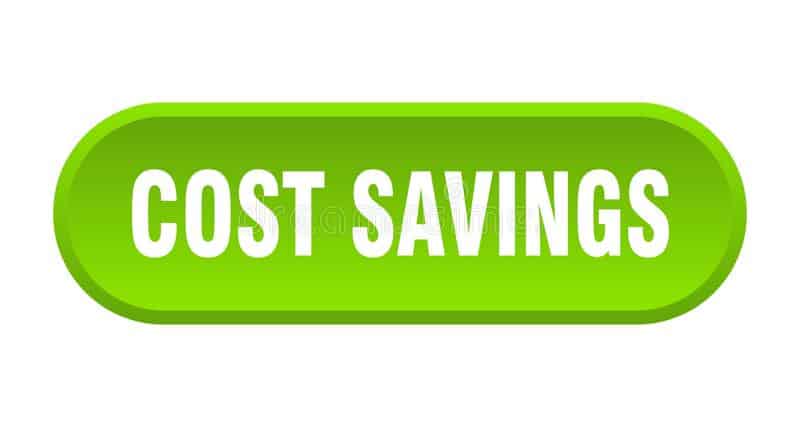Cost savings is an undeniably important concept in business. They are those savings that do not negatively affect the productivity or effectiveness of a company’s products or services. Therefore, it is safe to say that the concept of cost savings can make noticeable improvements in a company. In this article, we will be discussing cost savings for companies, the initiatives, calculations, and examples
Overview
Cost savings are savings that directly impact the company’s bottom line profits. These are the savings that are not likely to affect the quantity or quality of the products/services you render. You may also hear of these sorts of savings as cost reductions or ‘hard’ cost savings. For instance, cutting staff may not be an example of cost-saving, because you may not be able to create the same product or provide the same service. However, outsourcing your reception staff or employing a virtual assistant might be a way to cut costs while still providing the same service.
So anything to reduce current spending, which can be measured, and which doesn’t hurt your business can be seen as a cost-saving. The key is that your business needs to function in the same way with no negative impacts of any sort.
Examples include switching from expensive color printing to inexpensive black-and-white printing or reducing salaries paid by giving employees every other Friday off. These cost savings are easily quantifiable, and as a result, they get a great deal of attention because, as the saying goes, ‘you can’t manage what you can’t measure.” Well, you can measure cost savings, and they are managed as a result.
What Is Another Word for Cost Savings?
Some words that mean the same thing as “cost savings” are economical, thrifty, and sparing.
What Is Cost Savings Strategy?
Cost-reduction measures maximize operational efficiency. They handle everything from hiring to arranging flights. Successful implementation streamlines operations, allocates resources, and eliminates waste.
Why Is Cost Saving Important?
They generate more demand for the products, economies of large-scale manufacturing, more employment through industrialization, and an overall rise in living standards.
Examples of Cost Savings
You may see cost savings in several different ways in the business world. We’ll run through some of the ways you can increase your cost savings.
Examples of costs you may be able to cut include:
- Renegotiating your costs. For example, a retail outlet that renegotiates, rents during an industry turn down.
- Using freelancers or contract labor such as a live answering service.
- Pooling your resources with related businesses. Office space is an example.
- Buying in bulk (when it makes sense to do so).
- Identifying and eliminating wastes.
- Cutting down on luxuries such as first or business-class air travel and stays at expensive hotels.
- Usage of less physical resources, for example, an office that goes paperless tends to cut down on the cost of buying papers.
- You can also find partnerships that can help reduce your costs.
- Lastly, design processes, services, products, and practices to be more efficient and productive. Including applying all the cost savings examples.
Cost Savings Initiatives
Cost-savings initiatives can help offset rising expenses or falling profits. So, here are some cost savings initiatives you can apply to your business.
- Evaluate your expenses
- Set measurable cost-cutting goals
- Prioritize your biggest savings opportunities
- Adopt automation to increase efficiency
- Use outsourcing to cut payroll costs
- Negotiate discounts with suppliers and contractors
- Join buying groups
- Take advantage of invoice early-payment discounts
- Make your marketing and sales investments count
- Minimize space usage
- Implement energy efficiency to trim utility costs
- Track tax-deductible expenses
Cost Savings Calculation
As a consumer, you are always sorting for ways to save money when purchasing items, which means getting the best price you can find. Sometimes, you’ll need to calculate cost savings on particular items. This can be helpful when comparing purchases of goods that are slightly different, to see which deal, relatively, is better for the products offered. You may also want to use the calculation to check and see if the discounts that a merchant is offering are accurate with regard to the price. Either way, the solution to the cost savings calculation involves an arithmetic calculation that will render the result as a percentage.
To determine what discount or increase a price represents, you need to calculate the cost savings percentage. This basic calculation doesn’t require advanced algebra or calculus skills. You can set up the cost savings calculation in a spreadsheet program like Microsoft Excel but you can also calculate cost savings by hand. You will need to know both the current, discounted price and the original price.
Firstly, differentiate the original price of the product or service from the discounted price. For example, if the original, retail price of a pair of sneakers is $50, take $50 as your original price. Meanwhile, you ultimately paid $40 as your discount price. Minus the original price from the discount price: $50 – $40 =$10.
Therefore, the price difference or cost savings is $10
Secondly, divide the price difference by the original price. That’s $10 divided by the original $50, now amounting to 0.2.
Finally, multiply the decimal by 100 (or move the decimal point over two spaces to the right) to convert it to a percentage. That’s 0.2 multiplied by 100, finally giving you 20 percent. This means you saved 20% on your sneakers purchase.
Why Is Cost Savings Important in Business?
Cost savings boosts profitability, but only if sales prices and volume stay unchanged. If cost reductions result in a decline in the quality of the firm’s products, the corporation may be compelled to drop pricing in order to retain the same level of sales.
Cost Savings For Companies
Companies/businesses are built to generate profit in exchange for products and services. However, when the major objective of the company isn’t met, the opposite becomes the case. This means that the company will be on the verge of a great loss. It could eventually lead to a fold of the business. Cost savings for companies is generally important for businesses to grow and also strive in the market economy. So, let’s help you save cost and profit more, below is a guideline on cost savings for companies to save more and spend less while still providing quality in higher quantity.
#1. Always have a backup plan
If you possibly can arrange for an alternative place to run your business in case of a major disaster, you may be able to save on business interruption. Be prepared. Buying appropriate insurance upfront saves money in the long run, says Jeanne. So, why don’t you consider what situations would be catastrophic to your business and protect yourself with adequate insurance?
#2. Run from the law.
“Avoiding lawsuits is a big factor in business success,” says tax book author Crouch. “Even arbitration can get expensive.” The best alternative: Try to work out any problems before they grow to the point that attorneys get involved. “Don’t ignore any written or phone complaints.”
#3. Be a legal eagle.
When hiring an attorney, make sure you have a written fee agreement to prevent surprises. It should include an estimate of the time to be spent on your case and specify what’s covered the fee-including typing or copying and what is not.
#4. Time your payments.
Ask suppliers if they give discounts for early payment. However, If not, it’s to your advantage to pay your bills-including utilities, taxes, and suppliers-as late as possible without incurring a fee, advises Scott. “The longer funds are under your control,” he says, “the longer they’re earning a return for you rather than someone else.”
#5. Commission your sales force.
Overhead, salaries, incentives, training costs, fringe benefits, and expenses add up when you’re hiring your own sales representatives. Contracting independent manufacturers’ sales reps, paid on commission only, is less expensive and often equally effective
#6. Learn something new
Rather than paying a consultant to write your press releases, for example, hire one for an hour or so to show you how to do it yourself.
#7. Create a Website
Research your market and find potential visitors for your Web site by looking through forums on the Internet where people post messages for public viewing and special-interest groups related to your target market, product, or service.
#8. Set up your online store.
You’re probably thinking this might cost you so much, right? Well, it won’t. You can actually start selling items online without physically owning them. This remains one of the major examples and guideline on cost savings
Other Guidelines on Cost Savings Include
- Go with the flow. Rather than paying for employees who sit idle when business is slow, consider hiring temporary employees to handle surges in business.
- Experience counts. Get free or low-cost help and to give local college students a chance to learn the ropes by hiring interns.
- Be reluctant to give credit. If you do extend credit, thoroughly check the client’s credit background.
- Try being a good neighbor. This helps you split advertising and promotion costs with neighboring businesses.
- There’s nothing wrong with asking for help so you should learn to ask the people you know for help.
- When you’ve got a happy customer. Make a short video telling others what they’ve gained from using your products or services, your sources can encourage others to use your products or services.
- Offer expert advice. Teaching a class, speaking at a community meeting, or writing an article for a local paper not only makes you look like an expert but gathers low-cost attention for your business..
- Save up to 60 percent by buying used equipment ( that are still in good condition) for example computer equipment, copiers, and office furniture etc
The Process of Cost-Savings Analysis
Compiling a complete list of all the costs and benefits related with the project or choice should be the first step in a cost-savings analysis.
The following expenses may be incurred as part of a CBA:
- Direct costs in manufacturing include direct labor, inventory, raw materials, and production charges.
- Electricity, managerial overhead costs, rent, and utilities are examples of indirect costs.
- A decision’s intangible costs, such as the influence on customers, staff, or delivery schedules.
- Alternative investments or the cost of buying a plant vs building one are examples of opportunity costs.
- Costs associated with possible hazards such as regulatory issues, competition, and environmental consequences.
Advantages of Cost Savings For Companies
Increased revenue and sales as a result of increased production or the introduction of a new product.
Intangible benefits include increased staff safety and morale, as well as increased consumer satisfaction as a result of improved product options or faster delivery.
As a result of the choice, a competitive advantage or market share was acquired.
All of the things on the cost-savings list should be monetary measured by an analyst or project manager, taking extra care not to underestimate costs or overstate benefits. When giving a value to both costs and benefits for a cost-savings analysis, a conservative approach with a conscious attempt to eliminate any subjective tendencies when generating estimates is recommended.
Finally, the aggregate costs and benefits should be analyzed quantitatively to see if the advantages outweigh the disadvantages. If this is the case, the prudent course of action is to proceed with the project. Whether not, the company should examine the project to determine if it can be tweaked to boost benefits or lower costs in order to make it profitable. Otherwise, the firm should probably steer clear of the project.
How Do You Define Cost Saving?
The gain realized through activities that reduce an organization’s overall spending on assets that have a direct influence on its bottom line is known as cost savings. Cost-cutting measures include everything from increasing efficiency to negotiating reduced supply-purchase pricing.
What Are the 6 Types of Cost Savings?
- Historic cost savings,
- Budget cost savings,
- Technical cost savings,
- RFB cost savings,
- Index cost savings
- Ratio cost savings
How Do You Calculate Cost Savings in Procurement?
The average price of all submitted quotes less the negotiated contract price multiplied by the actual number of products purchased in a given period is the formula used to calculate procurement savings. This is a frequent technique, yet despite the apparent savings, expenses will rise.
Why Is Cost Savings Important?
Businesses can gain a financial advantage and improve their bottom line by incorporating cost-savings initiatives into their organizational plans.
Conclusion
Companies should note that applying the few tips that were discussed here(cost savings examples, initiatives, calculation, etc) to their business operations will help them make more profit, reduce waste, and generally give provide a better insight into what they should start doing.
FAQs
Why is cost savings important?
Businesses can gain a financial advantage and improve their bottom line by incorporating cost-savings initiatives into their organizational plans.
- Money Management: Top 10+ Easy Tips to Becoming a Pro
- MARKET GROWTH: Definition, Calculations, Rates, Strategies (Simplified)
- Financial Planning: Overview, Types, Importance, Concept (+ Free PDFs)
- FINANCIAL GOALS 2023: The Complete Guide for Students and Businesses (+ quick tips)
- Personal Finance: Basics, Importance, Types, Management ( + Free Software)
- Save Money Live Better: 15+ Best Easy Hacks for Millennials in 2023






